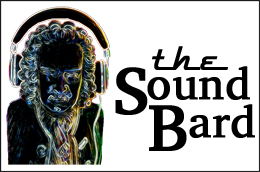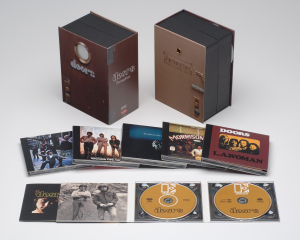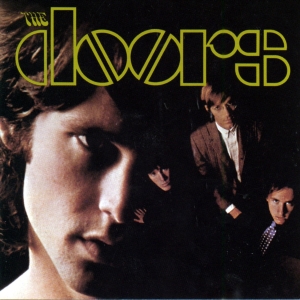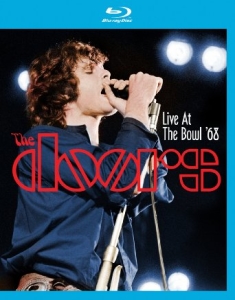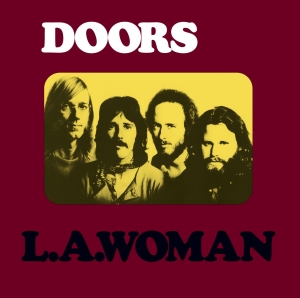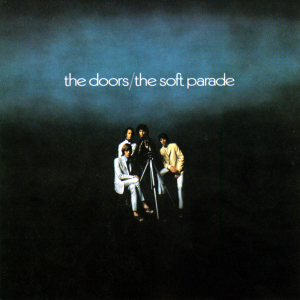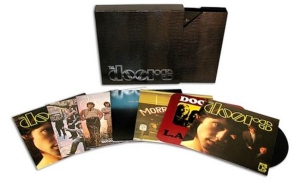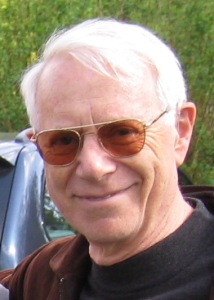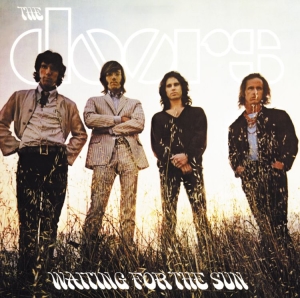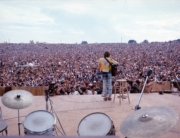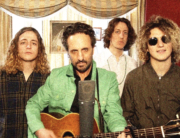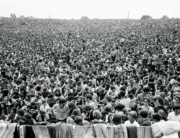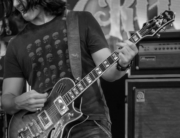BY MIKE METTLER — JUNE 25, 2015
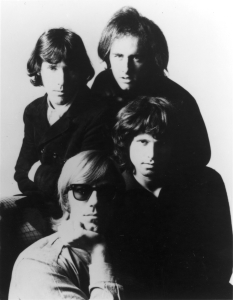
Riders of the Audio Storm: The Doors, clockwise from top left — John Densmore, Robby Krieger, Jim Morrison, Ray Manzarek. Photo courtesy of Elektra Records/Rhino.
Jac Holzman, the founder of Elektra Records, signed The Doors after seeing them play four consecutive nights as the Whisky a Go Go house band in Los Angeles in 1966. He went back on the second night out of deference to Arthur Lee of Love, a band that was already signed to Elektra, and then he saw the light and the fire on nights three and four. “I love The Doors. They changed the trajectory of my life,” Holzman admits. “And on that fourth night, they just blew it apart. They had it together. They were incandescent, and they were fueled by each other. They were the best band I ever heard, with songs that went deeper — songs that were daring to go places that you didn’t expect, from the weightiness of classic Greek mythology to ‘Hello, I love you, won’t you tell me your name?’”
The key, Holzman believes, is how the band and its ace production team — producer Paul A. Rothchild and engineer Bruce Botnick — all pulled together to make sure the integrity of the band’s sound was preserved on record. “We made albums so carefully,” Holzman notes. “I think the attention to the detail and the fussing over getting everything just right and not letting it go out otherwise are some of the reasons The Doors have held up over time. We had it right to begin with.”
Botnick’s studio acumen impressed Doors drummer John Densmore from the outset. “He made us feel secure,” he says. “He’s a world-class engineer, and he’s really the fifth Door, in a way. He was there when we made them, so those songs are in his blood too. And he’s overseen each new technology that’s come along and made sure we’re on the cutting edge, especially when it comes to surround sound.”
Guitarist Robby Krieger was also quite pleased with the sound of the band’s studio output. “I’m very happy with the results,” he acknowledges. “But when we heard ourselves on the radio, we never seemed as loud as the other songs. I’d ask, ‘Why is our song always so low coming out of the radio?’ According to Bruce, it was because we had more dynamic range than most bands.”
I rang Botnick up in California to discuss how he helped orchestrate The Doors’ formidable sonic legacy, how he translated said legacy into surround sound, and why he also still digs vinyl. Their music is your special friend, until the end.
Mike Mettler: If you don’t mind going back to the beginning, I’d like to discuss the Sunset Sound Recorders days, the 4-track universe you were in for the first record [1967’s The Doors]. Obviously Paul Rothchild had his vision, you had yours, and the band had theirs, so I wanted to see how that all intersected.
Bruce Botnick: Well, we always felt that The Doors were a performing band. We weren’t supposed to “create” The Doors in the studio — they were already The Doors. Basically, our thing was to be invisible, to be in the back and to document everything they were doing in the best way possible. Give them advice and guidance where necessary, stay out of the way, and let them, The Doors, shine. Robby [Krieger, guitarist] had his sound, Ray [Manzarek, keyboardist] had his sound, John [Densmore, drummer] had his sound, and Jim [Morrison, vocalist] had his sound.
Mettler: Some of my favorite early Doors moments come thanks to the echo chamber that studio had.
Botnick: It was Studio One that had an acoustic echo chamber, which is one of those freaks of nature; an anomaly. Capitol has eight acoustic chambers underground, and there’s one that’s spectacular, one that’s really good, and the rest are just also-rans. They’re identical, down to the millimeter. You could put the same gear, microphones, and speakers in the same space, but it just doesn’t sound the same. But the echo chamber at Sunset was always warm, and it had a lot of depth to it. Very musical.
Mettler: I love how you reimagined the core six-album studio catalog in 5.1 on the DVD-Audio discs in the Perception box set (2006). What’s your overall philosophy when it comes to surround-mixing The Doors? What did you want to present?
Botnick: I don’t think there’s an overall philosophy. Each song on each album has its own life. Instruments are supposed to go where instruments are supposed to go. On all the Perception discs, the goal never really was to do too much zooming from front to back. In some cases, Robby wanted it, and it was cute; it was ok.
The goal was to have the openness of the surround — left, center, right, and really use the center a lot. Most surround discs I hear are mixed for listening only, not film, and they basically avoid the center channel at all costs, because they’re so used to listening in stereo and they don’t understand the freedom of the center speaker. I will catch some heat for saying that. (chuckles)
Mettler: So what? Some vocalists, like Mick Jagger, have said they don’t want their vocals isolated in the center channel for various reasons; they don’t want to appear too naked.
Botnick: If there are drums and other things in there, you shouldn’t have a problem. If all you’re doing is putting just the lead singer in the center, then you’re in a little bit of trouble. Especially on the first album [The Doors], I used a little diversity to spread Jim’s vocal a little bit into the left and right, though, basically, it was still in the center. There’s not a lot you could do with basically three tracks.
Mettler: Well, it worked pretty effectively on “Crystal Ship.”
Botnick: Yes, and if you listen to “Horse Latitudes,” I put him in the middle of the five speakers, in the middle of the room, and everything else is revolving around it.
Mettler: I felt like I was on a rollercoaster on that track — which was a good thing, because it fit the character of that song.
Botnick: You hope that you got it right. After all, you could get nauseous. (both laugh)
Mettler: True! It was a good thing I was sitting down for that one.
Botnick: Yes! (laughs again) It’s like Disney’s cyclorama [i.e., CircleVision 360°]. If you were standing up, and it could move, you would fall over.
Have you heard the Blu-ray of the Hollywood Bowl [Live at the Bowl ’68] in surround?
Mettler: Yes, I have. It made me feel like I had a closer connection with a legendary performance. Will there be more live Doors in surround coming?
Botnick: If the market is there, I imagine we will. It isn’t that hard to do it; it just means firing up Pro Tools and opening it up into surround. There’s a little bit of balancing here and there, and you have to be ready for a change in environment, because the rooms are different. When we did Absolutely Live (1970), I think for one or two songs, we cut from New York to Pittsburgh, and to Philadelphia to Detroit. In those days, I had a pair of speakers in the rear for fun for mixing — we didn’t know about surround then — and I would put the live room in them. Every time we did a cut from a different show, you’d feel the size of the room change. In the front, you didn’t hear that much, but the rears would change dramatically, and that was very cool.
Mettler: You definitely got to use all of the surround channels on “Light My Fire” [on The Doors]. Things moved around based on the solo section you were working with.
Botnick: Right. But the song on the first album that really had separation was “The End.” We did that straight 4-track, but we had Jim in one, Ray in one, and Robby and John separate. It really made it nice, because that’s the only song on the album where the drums appear in the center.
Mettler: And we also get to hear the character of the tambourine on “The End” much, much clearer.
Botnick: To make that album work — and quite a few of the other ones, for that matter — the goal for me was to immerse people and put you into the room with them. To do that, I would use the outer space in my studio as an echo chamber. I had five Neumann M50 microphones, positioned as it would be in the listening area, and then used that combination with reverb to give you a sense of natural leakage into the rear so it didn’t have a mechanical or digital sound, but more of one that was organically analog.
Mettler: Another good example is what you did with “When the Music’s Over” [from 1967’s Strange Days].
Botnick: Oh yeah. When we got into the second album and beyond, we were into 8-track. I could position things in the rear speakers. I feel when people go out and get a surround disc, they should get a surround disc. Bring the neighbors over to hear a surround system! If there’s nothing coming out of the surround speakers but reverb, it’s a disappointment.
They need something to play, and I like to think the Perception box set really shines. I like to think cinematically in my head. You just sort of have a place when you hear the song for where it’s gotta go, without having anybody telling you where. It just happens. “Riders on the Storm” [from 1971’s L.A. Woman], without the rain and thunder, is an entirely different animal. It was great; it was. Putting the thunder and rain on it gave it that personality — and that was Jim’s idea. He’s the one who said, “It would be great to have thunder, rain, and lightning,” and it stuck in my head. I immediately knew what to do with it.
Mettler: Where did you find it? Did you go out and record storms for it?
Botnick: Jac Holzman found it in the streets of New York City, for his sound effects albums. The funny thing is, when I went back to mix it for surround, I didn’t realize that I hadn’t printed the rain and thunder on any 2-tracks. I didn’t have it. I just pressed START on the machine playing the rain and thunder and started the 8-track, and by accident, the thunder came where it was supposed to.
Mettler: It was pre-ordained, then.
Botnick: It was. When it came time to do the surround, I built it by using the very same rain and thunder. Made just continuous rain tracks, edited out the thunder, and used reverb and impulse responses in order to spread things like to create a space, like what you do for a movie sound design. [Botnick has been a scoring recordist and mixer for over 100 movies, many of them with the late composer Jerry Goldsmith, beginning with 1979’s Star Trek: The Motion Picture.]
Mettler: Perception itself is like an audio movie to me, where each song has a character that’s followed through. Now let’s talk about [1969’s] The Soft Parade, an album that incorporated horns and other instruments. How different was it working on the mix for that album?
Botnick: Because we could move things around and open things up on songs like “Tell All the People” and “Touch Me” — I believe I had all the strings and the brass in the rears. But if you wanted, you could turn off the back channels and just listen to the band. Robby has always said, “I’d like to put that album out without the strings and horns on it.” I said to him, “Well, just turn off the surrounds.”
Mettler: So your dream surround projects would be to do the rest of The Doors’ live material, and what else?
Botnick: I was very encouraged by The Hollywood Bowl. (pauses) Umm, I have some things I’m thinking about that I’d rather not talk about yet. But if we wanted to do some really good live ones, that would first be New York [January 18, 1970]. The Felt Forum is a great-sounding room. That would be nice. Boston [April 10, 1970], with all of its madness, with that revolutionary atmosphere — that would be cool. Those are some of the best-sounding ones.
There are so many different things. The good thing is, the ones that we put out there are unedited, warts and all, and they’re great. People will get to experience the concert as a whole.
Mettler: What’s your feeling about hi-res audio?
Botnick: It does sound better, but I still think DSD sounds the best. DTS’s Headphone:X surround system — I want to try it with The Doors to see if it would work. If it does, I think it would be a lovely way to go. And we could do it on vinyl. Imagine — surround on vinyl.
Mettler: I love that idea — a lot. Are you also still a proponent of vinyl?
Botnick: Oh goodness, yes! It sounds great. It’s amazing. Out here on the West Coast, we have two of the greatest mastering engineers of all time — Doug Sax and Bernie Grundman. You get to sit right there with them at Sterling Sound, and they have lovely gear — all tube, and great cutting heads. It’s wonderful. That, and the fact when you put a needle down on a record, you listen to the whole album. And all of The Doors albums we did were very carefully sequenced.
Mettler: A prime example of that would be Morrison Hotel (1970), with Hard Rock Café on one side, and Morrison Hotel on the other. Two different stories, with two different threads to follow.
Botnick: It’s not something you start out with, though. Even Sgt. Pepper didn’t start out that way. It evolved. And you have to have enough good sense to leave it alone and let it become what it’s going to become.
That’s one good thing Paul and I did — let it be. The adage is, “Don’t think; it’s dangerous.” If you’re thinking too much, you’re not going to let something good come.
Mettler: The perfectly sequenced album would be… what? Which one?
Botnick: All of them. (MM laughs) They’re all unique. Would I change it? No. The master of sequencing was Jac Holzman. Absolutely. He’s the one who came up with the whole philosophy of the “Four Corners”: There was the first song on Side 1, the last song on Side 1, leading to the first song on Side 2, and then the last song on Side 2. You pick your corners, and you created your flow in between them. That’s one way of doing a sequence. Some people did concept album, but this was not the case with The Doors. We didn’t do any concept albums. Albums became real, and The Doors were a great proponent of that.
Mettler: Here’s the hard question. If you could pick your favorite surround mix from the entire Perception box, could you do it?
Botnick: Just for your pure, show-your-system-off in surround, I would say “Horse Latitudes,” or “Riders on the Storm” — anything that was cinematic is lots of fun.
There are a lot of good things on there. Of course, in hindsight, you go back and listen and think, “Huh? Where I was coming from?” — but most of it I’m very, very happy with. I’ve heard it on big stages, we did When You’re Strange [A Film About The Doors; a 2010 documentary], I did quite a bit of material from the Perception box for that film. It worked out very nicely.
Mettler: I’d say “Not to Touch the Earth” is another demo surround track, along with “The Unknown Solider” [both from 1968’s Waiting for the Sun].
Botnick: Oh yeah! “Solider” is a good one, with the marching around the room. But you don’t want to do that just to do it; that would be a cheat. If it cinematically meant something and it would really enhance the song to that next level, you have to go there. You have to go there! But to do it just to do it is a cheat, and that wouldn’t hold up with the philosophy we had all these years, which was to be true to the music and true to the band.
Mettler: My final example would be on the song “L.A. Woman” (1971), where Jim’s vocal is moved around the channels — but it’s only after you’ve established the song, about 4 minutes into it.
Botnick: It did make sense, creatively, and it didn’t detract from the song. It’s like going to a movie theater with something in front of you, and something is coming out of the back and you can’t see it, but it’s back there. It can be confusing, so you have to be careful with how much you do. The idea is to envelop people, and give them a more immersive experience.
Tags: 5.1, Absolutely Live, Bruce Botnick, Crystal Ship, Elektra Records, Horse Latitudes, Jac Holzman, Jim Morrison, John Densmore, L.A. Woman, Light My Fire, Live at the Bowl 68, LP, Morrison Hotel, Not to Touch the Earth, People Are Strange, Perception, Ray Manzarek, Riders on the Storm, Robby Krieger, Strange Days, Sunset Sound Recorders, surround sound, Tell All the People, The Doors, The End, The Soft Parade, The Unknown Soldier, Touch Me, vinyl, Waiting for the Sun, When the Music's Over, When You're Strange